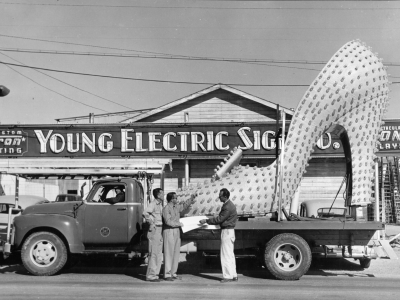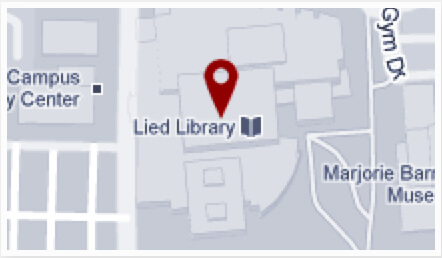"He had been rolling up and down the incredible electric-sign gauntlet of Las Vegas’ Strip, US 91, where the neon and the par lamps – bubbling, spiraling, rocketing, and exploding in sunbursts ten stories high out in the middle of the desert – celebrate one-story casinos."
"Las Vegas is the only town in the world whose skyline is made up neither of buildings, like New York, nor of trees, like Wilbraham, Massachusetts, but signs. One can look at Las Vegas from a mile away on Route 91 and see no buildings, no trees, only signs. But such signs. They tower. They revolve, they oscillate, they soar in shapes before which the existing vocabulary of art history is helpless … Boomerang Modern, Palette Curvilinear, Flash Gordon Ming-Alert Spiral, McDonald’s Hamburger Parabola, Mint Casino Elliptical, Miami Beach Kidney. Las Vegas sign makers work so far out beyond the frontiers of conventional studio art that they have no names themselves for the forms they create."
"In the Young Electric Sign Co. Era signs have become the architecture of Las Vegas, and the most whimsical, Yale seminar-frenzied devices of the two late geniuses of Baroque modern, Frank Lloyd Wright and Eero Saarinen, seem rather stuffy business, like a jest at a faculty meeting, compared to it."
"The boomerang modern … sunbursts are exploding in the Young Electric Sign Company’s Grand Gallery for all the sun kings."
Tom Wolfe
In Ogden, Utah, the Company was founded in 1920 by Tom Young, a gifted sign writer with $300 and the support of his wife Elmina. Tom had an even greater gift for the sign business. The story is told in the family that Tom brought his family to Las Vegas, then a small railroad town, in the late 1920's. While there, he purchased some butcher paper and colored pencils and designed, right then and there, on the wall of the family's hotel room at the El Cortez (not built until 1941) what would become the Boulder Club sign.
The Boulder Club introduced YESCO to Las Vegas in 1946 (maybe it later seemed like the 1920's to Tom Young, Jr.) Fremont Street had sported the signs of any western commercial downtown, but it soon became the aboveground test site for the Neon Explosion. The Boulder Club sign, towering over the street set the tone for overscaled signage that dwarfed the still western storefront buildings. Unlike the Strip, Fremont Street casinos were not architecturally striking in their own right. Inside they still looked like western saloons and gambling halls, at least until the Freemont Hotel transported Miami Modern to downtown in 1956. But even then, its high-rises would be dominated by the flashing street-level facades and towering signs. Juxtaposing a daytime and nighttime shot of Freemont Street graphically conveys the architectural quality of YESCO's neon.
The Boulder Club sign was followed by the 120-foot Las Vegas Club sign in 1942. It was taller than the Boulder Club sign, and completely overwhelmed the building to which it was attached, projecting a virtual architecture of light above the street.
Perhaps YESCO's most enduring image, constructed in 1951 for the Pioneer Club, was the 60-foot tall Vegas Vic, outlined in neon tubing, cigarette in mouth, jerking a thumb in a western "come on in" gesture has defined Las Vegas worldwide. The 'Howdy Pardner' cowboy created by an ad agency for the Chamber of Commerce festooned the city's promotional literature. He reflected the frontier west motif still favored by the city fathers -- despite or perhaps in defiance of the cool, nouveau Los Angeles chic, which was appearing on the Strip.
Glitter Gulch was YESCO's neon Gallery. It was the Fremont experience long before the city paid consultants to invent the concept. There YESCO sign artists redefined sign art. The street became one continuous neon display that defied or ignored the architecture behind it to become architecture in and of itself.
The Mint Hotel was perhaps the most striking example of a sign assuming an unprecedented architectural dimension with its long horizontal curve and its dramatic vertical upward "electro-organic" sweep, which exploded into a starburst at its zenith. As Alan Hess recounts "Compared with the Old West style encouraged by the Chamber of Commerce, the Mint, remembers architect Harris Sharp, "stunned a lot of people." And the Golden Nugget’s and the Horseshoe Clubs walls of neon made the corner of Freemont and Second, again, according to Hess, "one of the great moments in American urbanism."
The Strip belonged to YESCO as well. In 1964 when New York writer Tom Wolfe visited Las Vegas, it was the YESCO signs he saw instead of buildings or trees. YESCO built Wilbur Clark's Desert Inn Cactus Sign, the Sands Script-on-Egg-Crate sign, and perhaps the defining Strip sign, the cosmic Stardust starburst sign. In 1958 the Stardust sign was the largest sign in Las Vegas, a massive piece of Marvel Comic bas relief and light that covered the entire front of an otherwise nondescript warehouse-like casino, "a decorated shed" according to Learning from Las Vegas authors and gurus of all intellectually trendy Las Vegas architectural history, Robert Venturi, Denise Scott Brown and Steven Izenour. The sign " boasted thousands of flashing light bulbs and neon tubes, simulated stars and planets against a lunar background," according to YESCO's corporate history A Legacy of Light. Alan Hess devotes eight pages of his Viva Las Vegas to the Stardust and its sign. It was for Hess one of the icons by which Las Vegas defined American culture, a roadside sign - an art form for the mass market. In the words of architectural historian J.B. Jackson,
In all those streamlined facades, in all those flamboyant entrances and deliberately bizarre decorative efforts, those cheerfully self-assertive masses of color and light and movement that clash roughly with the old and traditional, there are certain underlying characteristics which suggest that we are confronted not by a debased and cheapened art, but a kind of folk art in mid-twentieth-century garb.
Hess concludes that the Stardust "was a billboard that advertised nothing less than the universe itself" which is perhaps the defining statement of Las Vegas today. YESCO still inscribes the night sky from the Rio to the giant electric guitars over the entrances to the Hard Rock Cafe and Hotel -- the neon that competes with the backlit sunset architecture of Las Vegas' natural mountains and desert. It is there. When we fly home to Las Vegas from wherever, we cannot fail to be struck by that glow in the sky.
Acknowledgements.
Obviously this essay relied on and borrowed heavily from Alas Hess’ Viva Las Vegas:
After Hours Architecture, Chronicle Books, San Francisco, 1993
Tom Wolfe’s article “Las Vegas (What?) Las Vegas (Can’t Hear You! Too Noisy) Las Vegas!!!!!” first appeared in Esquire Magazine in 1964 and was reprinted in The Kandy- Kolored Tangerine-Flake Streamline Baby, Farrar, Straus & Giroux in 1965



